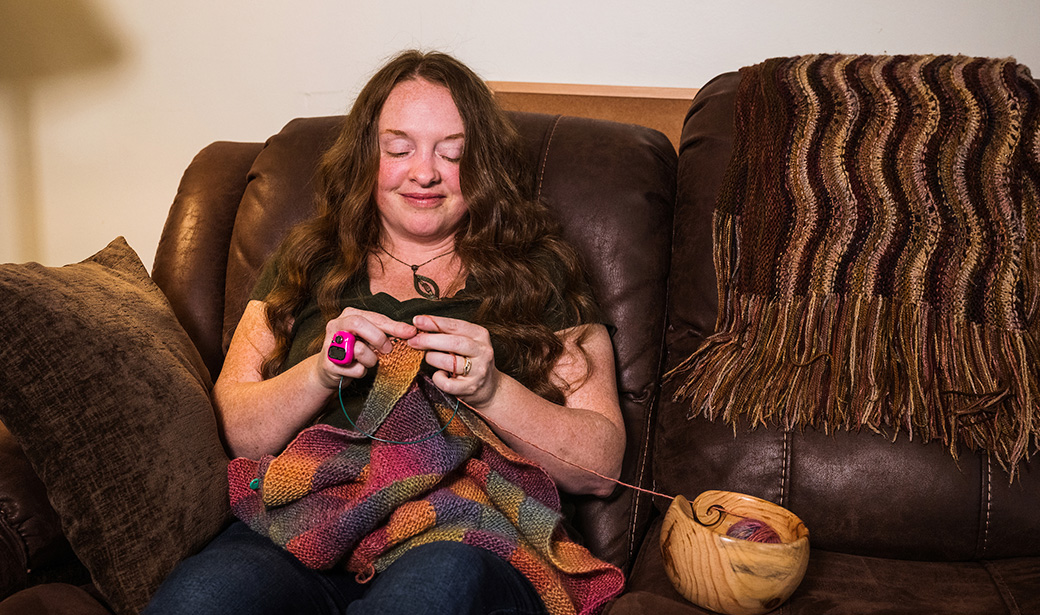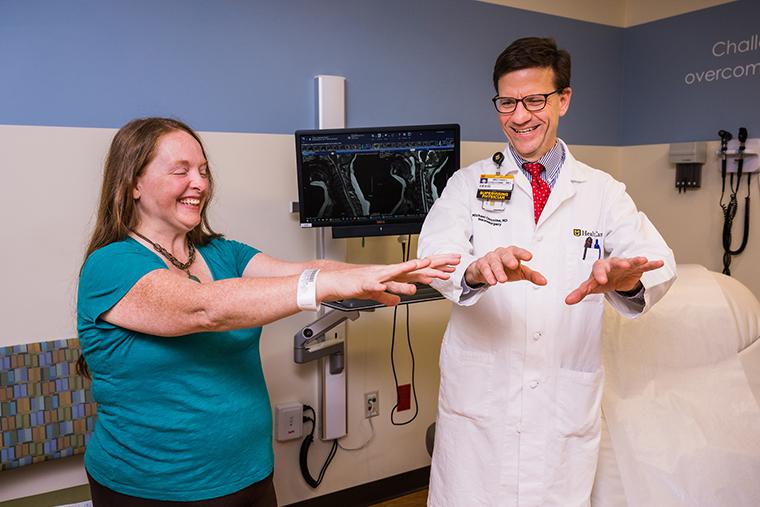Stephanie Lyman, a mid-Missouri transplant from Arizona, knows her way around a yarn store. The 42-year-old Fulton resident and fiber arts hobbyist taught herself to knit in 2014, creating shawls, scarves, cowls and other pieces of clothing for herself and her family. Then it was crocheting and learning how to spin yarn on a spinning wheel.
“I love yarn because it just has so much potential in it,” Lyman said. “It's going to become something, it's going to be meaningful to somebody, either myself or somebody I gift it to, it’s going to be appreciated and it will care for somebody I love. That’s special.”
But in 2019, neck pain and numbness in her fingers forced Lyman to give up the fiber arts she loved. She couldn’t feel the texture of the yarn, judge its gauge or hold her needles comfortably.
Lyman’s health issues were first diagnosed as Lyme Disease, and three years of attempting to treat it were unsuccessful. When Lyman went to her doctor in 2022, she was at a low point: She was having difficulty breathing, and she hadn’t walked without assistance in months.
“My health issues had been picking up, and it was like I kind of fell off a cliff,” Lyman said. “I came in in a wheelchair, because at that point I was almost immobile from the neck down. I could barely lift my left arm.”
Her doctor referred her to the neurological specialists at MU Health Care. Because her symptoms were present in both her spine and extremities, Lyman and her doctors decided to do a full evaluation to look for what others might have missed.
Farhan Siddiq, MD, a neurological surgeon who specializes in spine surgery, said that evaluation was a key step for Lyman.
“Sometimes it gets a little confusing when people have symptoms that could correlate to different conditions,” Siddiq said. "She's in the age range for patients to present with Lyme Disease, multiple sclerosis or other neurologic diseases. But as treatment happened, she continued to progress, and her weakness continued to get worse.”
Lyman was scheduled for an MRI just a few days before Halloween in 2022, and that scan showed a clear problem. She had a tumor in her spinal tube.
Michael Chicoine, MD, a neurosurgeon who specializes in brain tumors, said her tumor, a meningioma, is relatively common. The location, however, was not. Because Lyman’s tumor developed just below the base of her skull, a small amount of growth had a dramatic impact, preventing her brain signals from reaching the rest of her body.
“The spinal cord is about as big around as your little finger, and it's in a tube called the spinal canal, which protects it,” Chicoine said. “In her case, in addition to the spinal cord, in that tube was the tumor, the size of a small walnut or ping pong ball, compressing the spinal cord up against the side of that tube.”
Chicoine, Siddiq and other experts at MU Health Care recommended Lyman have surgery to remove the tumor to relieve the compression and restore her nerve function.
There were potential risks to surgery, but if successful, it would offer relief much faster than radiation, which could take years to shrink the tumor and might damage healthy brain tissue or her spine. And left untreated, her condition would only worsen until she would no longer be able to breathe on her own.
The news took a crushing weight off the shoulders of Lyman and her family.
“I was so relieved, to be quite honest, because I had been dealing with a lot of troubles for so long, and not knowing the answer was hard,” Lyman said. “My husband was my 24/7 care provider at home, and it had gotten bad. We were desperate for solutions. We were desperate for answers. I got an answer, and then I knew there was a solution that was operable. The relief that flooded our hearts was huge.”
Siddiq and Chicoine performed the complex surgery together aided by neurological monitoring, which uses electrodes placed in specific areas of the brain and on the body. This gives surgeons real-time updates on the spinal column’s function to guard against potential complications or damage.
Once they had successfully removed the tumor, Lyman’s neurological monitoring improved almost immediately, which Siddiq said was a rare occurrence.
Though Lyman’s health deteriorated quickly, her recovery was even faster. She was able to sit up in bed and move her hands and arms within 24 hours, and less than a week after surgery, Lyman got out of bed and moved around her hospital room with a walker.
Lyman found joy in doing daily tasks that many of us take for granted, grinning ear to ear as she ate without assistance, trimmed her fingernails, shampooed her wavy red hair, journaled with pen and paper or texted family about the progress she made that day in physical therapy. She was careful about picking up her knitting needles and yarn again before deciding the time was right in February of 2023.
“Knitting is a special passion of mine, so I took longer,” Lyman said. “I probably could have picked it up sooner, but I grieved it and so I had to give myself time to be ready to pick it up again and have a new experience with it. Because when you lose something and you get it back, it’s not the same experience, it's a new experience. I felt grateful, and I felt ready, just, ‘I know I can do this again.’”
Her first project as she resumed knitting was a leaf-shaped dish cloth, one of the first things she learned how to knit the first time around. It holds a spot of honor on her bedroom wall as a reminder of her journey.
“Her case is remarkable,” Siddiq said. “Seeing her recovery is heartwarming and inspiring. The reason we do this day in and day out is to see outcomes like Stephanie’s.”






